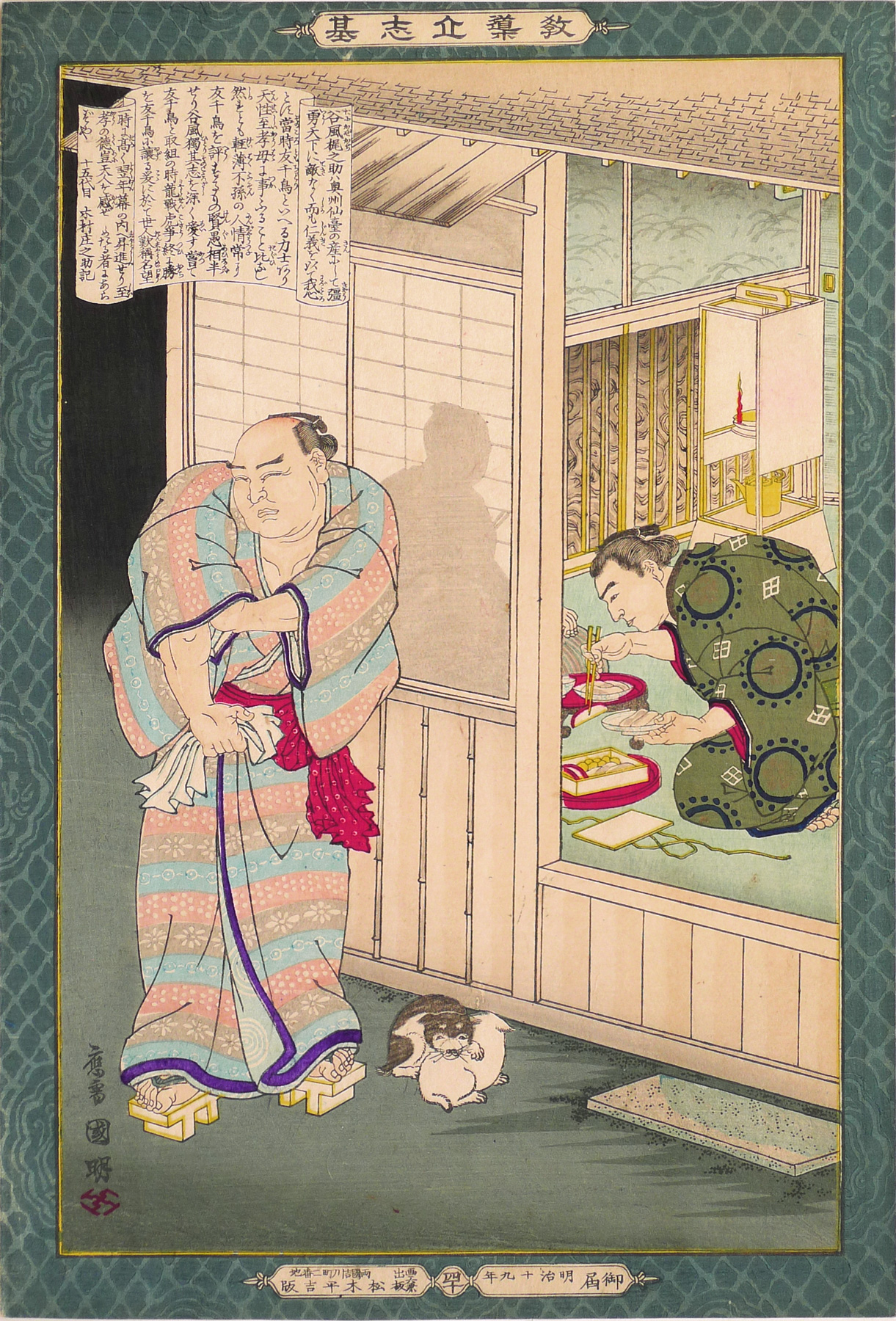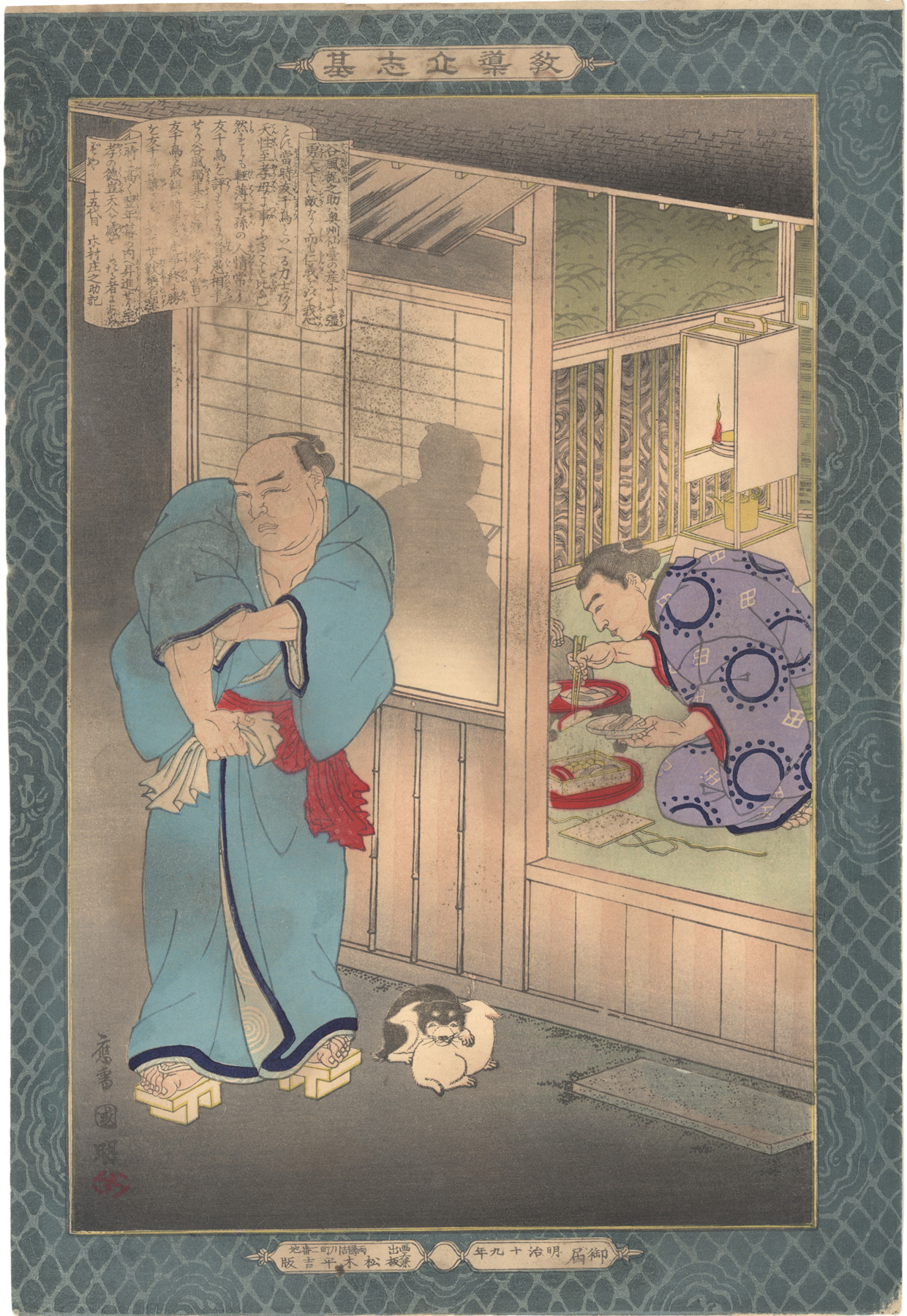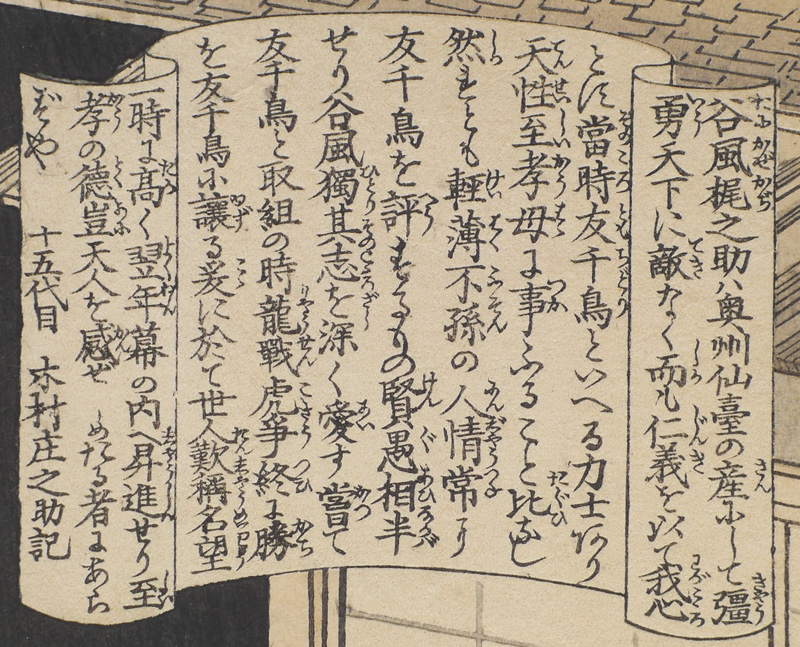About This Print
Print number 四十 (40)1 in the series Instructive Models of Lofty Ambition picturing the famous rikishi (sumo) Tanikaze Kajinosuke (1750-1795) outside the home of the younger, and less accomplished, wrestler Tomochidori (b. 1756). Tomochidori, who is struggling financially, is seen feeding delicacies to his sick father, who is only seen in silhouette. His sacrifices to buy food and medicine for his father and forego his own well-being is a demonstration of shikō, or supreme filial piety. Tanikaze is reaching into the sleeve of his robe, perhaps to retrieve money to give to Tomochidori.Kuniaki contributed a single print to this series and it is fitting that it involves sumo, as Kuniaki's most famous print is that of a sumo (see the artist's biography for more detail on this famous print) and he is best known for his sumo prints.
1 Numbering of the prints was haphazard during the production of the series. Print numbers were sometimes inadvertently omitted; some prints in the series were never assigned numbers and a few of the same numbers appear on different prints.
2 Kiyochika Artist of Meiji Japan, Henry D. Smith II, Santa Barbara Museum of Art, 1988, p. 74.
Variant printings
Three variant color printings are known to have been made for this print, as shown below.
click on image to enlarge
Tomochidori and Tanikaze Kajinosuke
Source: Wikipediaen.wikipedia.org/wiki/Tanikaze_Kajinosuke and the website http://sumodb.sumogames.de/Rikishi.aspx?r=4417&t=1Tanikaze Kajinosuke (谷風 梶之助, September 8, 1750 – February 27, 1795) was a sumo wrestler in Japan in the Tokugawa era, and the first to be awarded the title of Yokozuna within his own lifetime. Tomochidori (b. 1756) was a lesser wrestler active from 1779-1796. It is said that Tomochidori impressed Tanikaze with his filial piety, by foregoing his own well-being to care for his sick father. It may be that Tanikaze had asked Tomochidori for a loan or that Tanikaze hearing about Tomochidori's sacrifice decided to lend him money. It is also said that Tanikaze caused a sumo bout to be set up with Tomochidori as his opponent and then allowed him to win, greatly increasing Tomochidori's reputation and income.
Transcription of Scroll
Source: with thanks to Yajifun http://yajifun.tumblr.com/40 Tomochidori (& Tanikaze) 友千鳥(谷風)
教導立志基 四十 友千鳥 谷風 二代目歌川国明(蜂須賀国明) 1886年
Transcript: [scroll text by 十五代目 木村庄之助 (15th generation Kumura Shōnosuke]
“谷風梶之助ハ奥州仙臺(仙台)の産にして彊勇(強勇)天下に敵なく而も仁義を以て我心とす當時(当時)友千鳥といへる力士あり 天性至孝 母に事(つか)ふること比(たぐひ)なし 然(しか)れども軽薄不孫の人情 常に友千鳥を評するもの賢愚相半ばせり谷風獨(独 ひとり)其志を深く愛す 嘗て友千鳥と取組の時 龍戰(戦)虎争終に勝を友千鳥に譲る爰に於て世人歎稱(歎称)名望一時に高く翌年幕の内へ昇進せり至孝の徳 豈天人を感ぜしめたる者にあらずや 十五代目 木村庄之助 記”
About The Series "Kyōdō risshi no motoi"
Notes:1. This series is variously translated as "Instructive Models of Lofty Ambition," "Foundations of Learning and Achievement," "Foundation of Instruction and Perseverance," "Self-Made Men Worthy of Emulation," "Paragons of Instruction and Success," "Moral of Success," "Examples of Self-Made Leaders," and "Instruction in the Fundamentals of Success." The title in Japanese is sometimes seen as "Kyōdō risshiki or "Kyōdō risshi no moto," in addition to the most commonly seen transliteration of "Kyōdō risshi no motoi".2. For a complete listing of all the prints in the series and additional information please see the article on this site titled Instructive Models of Lofty Ambition.
This series ran between October 1885 and November 1890 and featured a long list of heroes and heroines, from antiquity to contemporary times, who were regarded as standards of moral leadership and self-realization.
Source: Kiyochika Artist of Meiji Japan, Henry D. Smith II, Santa Barbara Museum of Art, 1988, p. 74-75; original research and as footnoted.
This series of 58 prints,1 plus a table of contents sheet (目録), were originally published between October 1885 and November 1890 by the Tokyo publisher Matsuki Heikichi 松木平吉.2 The table of contents sheet issued by the publisher states that "fifty prints make up the complete set (五十番揃)". Three prints not in the initial release were added over the five year publication period, as were five redesigns of original prints, eventually increasing the total print count to 58. The seven artists contributing prints were Kobayashi Kiyochika (1847-1915) [20 prints], Mizuno Toshikata (1866-1908) [16 prints], Inoue Tankei (Yasuji) (1864-1889) [13 prints], Taiso (Tsukioka) Yoshitoshi (1839-1892) [5 prints], Yōshū Chikanobu (1838-1912) [2 prints], Toyohara Kunichika (1835–1900) [1 print], and Hachisuka (Utagawa) Kuniaki II (1835-1888) [1 print]. All the artists, with the exception of Yōshū Chikanobu, are listed in the top scroll of the table of contents sheet. Various colors (including blue, blue/green, and tan/brown) were used for the decorative border, and in 1902 the series was re-issued by Matsuki without borders.
Brief texts contained within a scroll-like cartouche appearing on each print provide historical details. The scroll composer's name is given at the end of the scroll text. The “lofty ambition” of the title is a Confucian concept, originally from Mencius, meaning “righteous determination that would inspire others.” The market for the series probably included former samurai, ambitious youth, and conservative intellectuals.
"[W]hen it was completed in 1890 the publisher was singled out for special recognition by the government for having sponsored such noble subject matter."3
This series ran between October 1885 and November 1890 and featured a long list of heroes and heroines, from antiquity to contemporary times, who were regarded as standards of moral leadership and self-realization.
Source: Kiyochika Artist of Meiji Japan, Henry D. Smith II, Santa Barbara Museum of Art, 1988, p. 74-75; original research and as footnoted.
This series of 58 prints,1 plus a table of contents sheet (目録), were originally published between October 1885 and November 1890 by the Tokyo publisher Matsuki Heikichi 松木平吉.2 The table of contents sheet issued by the publisher states that "fifty prints make up the complete set (五十番揃)". Three prints not in the initial release were added over the five year publication period, as were five redesigns of original prints, eventually increasing the total print count to 58. The seven artists contributing prints were Kobayashi Kiyochika (1847-1915) [20 prints], Mizuno Toshikata (1866-1908) [16 prints], Inoue Tankei (Yasuji) (1864-1889) [13 prints], Taiso (Tsukioka) Yoshitoshi (1839-1892) [5 prints], Yōshū Chikanobu (1838-1912) [2 prints], Toyohara Kunichika (1835–1900) [1 print], and Hachisuka (Utagawa) Kuniaki II (1835-1888) [1 print]. All the artists, with the exception of Yōshū Chikanobu, are listed in the top scroll of the table of contents sheet. Various colors (including blue, blue/green, and tan/brown) were used for the decorative border, and in 1902 the series was re-issued by Matsuki without borders.
This series of 58 prints,1 plus a table of contents sheet (目録), were originally published between October 1885 and November 1890 by the Tokyo publisher Matsuki Heikichi 松木平吉.2 The table of contents sheet issued by the publisher states that "fifty prints make up the complete set (五十番揃)". Three prints not in the initial release were added over the five year publication period, as were five redesigns of original prints, eventually increasing the total print count to 58. The seven artists contributing prints were Kobayashi Kiyochika (1847-1915) [20 prints], Mizuno Toshikata (1866-1908) [16 prints], Inoue Tankei (Yasuji) (1864-1889) [13 prints], Taiso (Tsukioka) Yoshitoshi (1839-1892) [5 prints], Yōshū Chikanobu (1838-1912) [2 prints], Toyohara Kunichika (1835–1900) [1 print], and Hachisuka (Utagawa) Kuniaki II (1835-1888) [1 print]. All the artists, with the exception of Yōshū Chikanobu, are listed in the top scroll of the table of contents sheet. Various colors (including blue, blue/green, and tan/brown) were used for the decorative border, and in 1902 the series was re-issued by Matsuki without borders.
Brief texts contained within a scroll-like cartouche appearing on each print provide historical details. The scroll composer's name is given at the end of the scroll text. The “lofty ambition” of the title is a Confucian concept, originally from Mencius, meaning “righteous determination that would inspire others.” The market for the series probably included former samurai, ambitious youth, and conservative intellectuals.
"[W]hen it was completed in 1890 the publisher was singled out for special recognition by the government for having sponsored such noble subject matter."3
1 The Tokyo Metropolitan Library online collection shows 50 prints and a Table of Contents sheet. The Table of Contents lists the titles of 50 prints. Smith in Kiyochika Artist of Meiji Japan identified 52 prints. I have identified 58 prints from this series including five prints (Ikina, Michizane Sugiwara, Kesa Gozen, Soga Brothers and Hokiichi Hanawa) that were re-designed and re-printed, likely due to damaged or lost blocks.
2 Robert Schaap notes in Appendix II, p. 166 of Yoshitoshi, Masterpieces from the Ed Freis Collection, Chris Uhlenbeck and Amy Reigle Newland, Hotei Publishing, 2011 that the series originally appeared as newspaper supplements.
3 The World of the Meiji Print: Impressions of a New Civilization, Julia Meech-Pekarik, Weatherhill, 1986, p. 122.
1 The Tokyo Metropolitan Library online collection shows 50 prints and a Table of Contents sheet. The Table of Contents lists the titles of 50 prints. Smith in Kiyochika Artist of Meiji Japan identified 52 prints. I have identified 58 prints from this series including five prints (Ikina, Michizane Sugiwara, Kesa Gozen, Soga Brothers and Hokiichi Hanawa) that were re-designed and re-printed, likely due to damaged or lost blocks.
2 Robert Schaap notes in Appendix II, p. 166 of Yoshitoshi, Masterpieces from the Ed Freis Collection, Chris Uhlenbeck and Amy Reigle Newland, Hotei Publishing, 2011 that the series originally appeared as newspaper supplements.
3 The World of the Meiji Print: Impressions of a New Civilization, Julia Meech-Pekarik, Weatherhill, 1986, p. 122.
Print Details
| IHL Catalog | #1036; #2254 |
| Title or Description | Tomochidori 友千鳥 |
| Series | “Instructive Models of Lofty Ambition” (Kyodo risshiki 教導立志基) [note: series title also listed as 'Kyodo Risshi no Moto', ‘Kyodo risshi no motoi’, ‘Kyōdō risshi ki’ and variously translated as “Moral of success” or “Foundations of learning and achievement” or “Self-made Men Worthy of Emulation”' or “Examples of Self-made Leaders” or "Paragons of instruction and success"] |
| Artist | Utagawa Kuniaki II (1835-1888) |
| Signature |  |
| Seal | |
| Publication Date | 1886 明治 十九年 |
| Publisher | Matsuki Heikichi (松木平吉) proprietor of Daikokuya Heikichi [Marks: seal not shown; pub. ref. 029] IHL Cat. #1036 (from right to left) publishing and printing date: 御届 明治 十九年 [notification delivered, Meiji 19th year] assigned number within series: IHL Cat. #1036 四十 [40]; IHL Cat. #2254 left blank publisher information: 画工兼 出版 両国吉川町二番地 松木平吉 版 [artist and publisher Ryōgoku Yoshikawachō 2-banchi Matsuki Heikichi han] |
| Engraver | |
| Impression | IHL Cat. #1036: excellent IHL Cat. #2254: excellent |
| Colors | IHL Cat. #1036: excellent IHL Cat. #2254: fair - soiling and rubbing but colors unfaded |
| Condition | IHL Cat. #1036 :excellent - Japanese album backing paper; very minor marks and flaws; 3/8 in. trimmed from brocade border IHL Cat. #2254: fair - extensive soiling and rubbing and light toning; minor paper loss and thinning along left margin; not backed |
| Genre | ukiyo-e; rishki-e; kyōiku nishiki-e |
| Miscellaneous | print number 40 (四十); position 40 in the Table of Contents for the series |
| Format | vertical oban |
| H x W Paper | IHL Cat. #1036:13 7/8 x 9 3/8 in. (35.2 x 23.8 cm) IHL Cat. #2254:14 5/8 x 9 7/8 in. (37.1 x 25.1 cm) |
| H x W Image | IHL Cat. #1036:13 7/8 x 9 3/8 in. (35.2 x 23.8 cm) [12 5/8 x 8 1/4 in. (32.1 x 21 cm) area inside brocade border] IHL Cat. #2254:14 1/2 x 9 7/8 in. (36.8 x 25.1 cm) [12 5/8 x 8 1/4 in. (32.1 x 21 cm) area inside brocade border] |
| Literature | |
| Collections This Print | Tokyo Metropolitan Library 2421-K2; Tokyo Digital Museum (Edo-Tokyo Museum) 96200391; Tsubouchi Memorial Theatre Museum of Waseda University 401-0559, 201-3021 |
3/31/2020
11/12/2019





